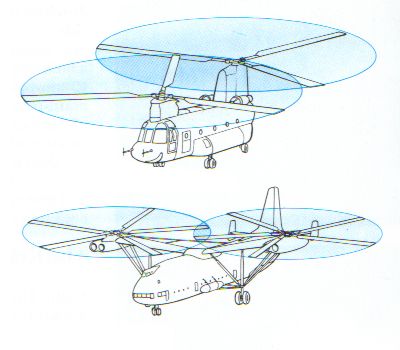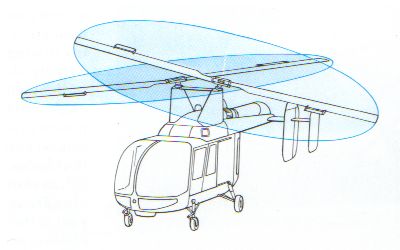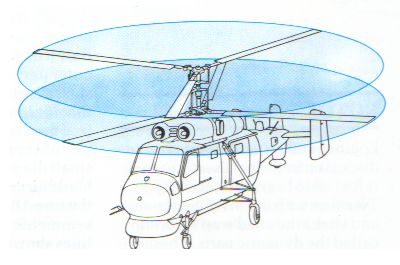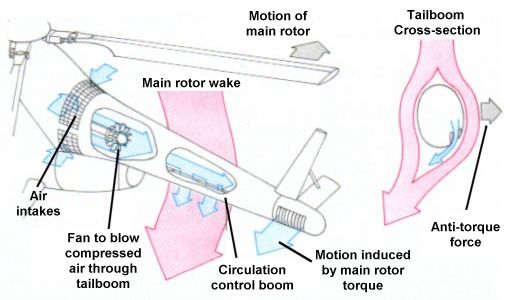|
||||||||||
|
|
||||||||||
|
||||||||||
|
|
||||||||||
To fully understand the purpose of tail rotors and helicopter yaw control, we must go back in time to the 1600s when Sir Isaac Newton developed his laws of motion. Newton's third law of motion, in its popular form, says that "Every action has an equal and opposite reaction." Keeping this in mind, think of a typical helicopter with a single rotor. As the rotor spins clockwise at a high rate of speed, there is an equal and opposite reaction acting on the helicopter fuselage making it want to spin counterclockwise. To keep the helicopter from becoming a flying pinwheel, we must somehow exert a force on the fuselage to counteract that of the main rotor. Notice that I haven't said anything about tail rotors yet. In fact, if a helicopter were to be flying forward fast enough, a vertical tail like that used on an airplane would provide enough force to counteract the torque of the main rotor, without any tail rotor! In fact, this mode of flight is actually one of the emergency procedures recommended when a tail rotor malfunctions. Of course, one of the reasons helicopters were developed in the first place was the desire to hover over one spot with no forward velocity. This requirement then brings us back to the need for some kind of force to counteract that of the main rotor.
Depending on who you ask and how you count, there are four different ways to counteract the force of the main rotor: a tail rotor, twin non-coaxial rotors (either tandem, side-by-side, or intermeshing), twin coaxial rotors, and the NOTAR system. We believe that NOTAR is the particular method you are referring to in your question, but let us explore each of these options for the sake of completeness.
Tail Rotor:

By far the most common method for yaw control was first used by Igor Sikorsky in 1941. Sikorsky's configuration featured a single main rotor with a small tail rotor mounted at the end of a long tail boom, as exemplified by the AH-64 Apache. While the main rotor generates the lift and thrust that make flight possible, the purpose of the tail rotor is to counteract the torque effect. The tail rotor works much like any propeller or rotor. It spins at a high rate of speed, accelerating air in a specific direction, to create a force in the opposite direction that counteracts the force of the main rotor. The pilot of the helicopter can alter the properties of the tail rotor to increase or decrease this force thereby causing the helicopter to yaw to either the left or the right. To maximize the force of the tail rotor, the rotor is usually mounted on a considerably long tail boom. There are two notable disadvantages of this arrangement. First, the long tail boom creates an aircraft with a large "footprint," meaning it needs more space for maneuvering and storage. Second, while the helicopter is on the ground, the spinning tail rotor is usually low to the ground so that it presents a hazard, often a fatal one, to ground crew.
Keep in mind that this approach is only ONE way to counteract the torque effect, and while it is the most common, it is generally considered the most complex! Just like a car isn't the only way to get around town (I personally use a human-powered spring, aka a pogo stick), the tail rotor isn't the only way to counteract the torque of a helicopter rotor.
Twin Non-Coaxial:

If you are going to build a large helicopter for lifting heavy loads, then it makes sense to use two separate rotors to generate more lifting force. If these rotors are separate, such as those on the CH-46 Sea Knight or the V-22 Osprey, then they are called "non-coaxial," meaning they do not share the same axis. Since these helicopters have two rotors that are usually equal in size, the simple solution to the yaw control problem is to spin the rotors in opposite directions. Thus, the yaw forces created by each rotor cancel each other out. Yaw control is achieved by tilting the rotors in opposite directions (to the left and right in the case of the CH-46).

A subgroup of twin non-coaxial rotors is the twin intermeshing rotor system, seen only on a few helicopters made by the Kaman company, including the H-43 Husky and K-MAX. The principles by which intermeshing rotors operate are the same as those previously discussed for other twin rotor helicopters. The difference is that the rotors are mounted very close together and actually intermesh, i.e. the blades on one rotor travel through the rotor disk of the other rotor. Of course, the intermeshing of the rotors is carefully timed to keep the rotors from chopping each other to pieces. There aren't many flyable H-43s left, but when they are airborne, they are indeed an interesting sight.
Twin Coaxial:

Another yaw control strategy pioneered by the Russian manufacturer Kamov utilizes two rotors that share the same axis (coaxial), an example being the Ka-50. Much like the non-coaxial design, the rotors rotate in opposite directions, each one counteracting the yaw force of the other. Yaw control is achieved by increasing the blade pitch on one rotor while decreasing the pitch on the other. The result is a differential in torque, resulting in a yawing motion. The most notable advantage of the twin coaxial arrangement is that it is very compact. Although the twin rotor configuration tends to be rather tall, the lack of a long tail boom results in a very short fuselage that takes up much less space. For this reason, Kamov designs have proven very popular for shipboard use with the Russian Navy.
NOTAR:

By far the most recent yaw control strategy developed for helicopters is the NO TAil Rotor (NOTAR) design. NOTAR was first developed by McDonnell Douglas during the 1980s and applied to a modified OH-6 Cayuse. The concept proved so successful that the company began marketing dedicated NOTAR spinoffs of the successful MD 500 family including the MD 520N. The NOTAR system operates by forcing moving air out of slots located on the tail boom. The interaction of this air flow with the downwash of the main rotor is such that it creates a force that opposes the torque of the main rotor. While there are some complex aerodynamics involved, the general idea is to replace a spinning tail rotor with a jet of compressed air squirting out of one side of the tail boom. Varying the strength of the jet gives the pilot yaw control over the helicopter. The NOTAR system is currently available on a number of commercial helicopters including the MD 520N, MD 530N, and MD 600N, and has even made some Hollywood appearances (such as Speed, featuring the lovely Sandra Bullock and the "talented" Keanu Reeves). Though the NOTAR arrangement still requires a long tail boom, the need for a spinning tail rotor is eliminated. This reduces the danger to ground crew, and also allows the pilot to maneuver into positions that he or she normally would not even consider. For example, NOTAR allows a pilot to stick the tail boom into a tree. Try that with a standard tail rotor, and it will be time for an unscheduled landing.
We hope that this in-depth discussion satisfies any questions you might have about helicopter tail rotors. Of
course, someone might come up with a better, simpler way of counteracting the force of the main rotor in a few
years. Then again, someone might perfect flying saucer technology too, making helicopters a thing of the past.
As for me, I'll put my money on helicopters being around for a while...
- answer by Doug Jackson, 8 July 2001
Related Topics:
Read More Articles:


|
Aircraft | Design | Ask Us | Shop | Search |

|
|
| About Us | Contact Us | Copyright © 1997-2023 | |||
|
|
|||